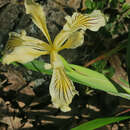Comments
provided by eFloras
Iris bracteata is limited to one county each in northern California and southern Oregon. It hybridizes with I. chrysophylla, I. douglasiana, I. innominata, I. munzii, I. purdyi, and I. tenax.
- license
- cc-by-nc-sa-3.0
- copyright
- Missouri Botanical Garden, 4344 Shaw Boulevard, St. Louis, MO, 63110 USA
Description
provided by eFloras
Rhizomes sheathed with old leaf bases, slender, 0.6–0.9 cm diam.; roots few, fibrous. Stems simple, solid, 1.5–3 dm. Leaves: basal with abaxial surface of blades deep glossy green on one side of fan, light yellow-green on other side, pink or red-tinged basally, strongly ribbed, 4–6 dm × 0.8–1 cm, rigid, margins not thickened; cauline 3–6, imbricated, closely sheathing stem ca. 2/3 length, spreading distally, bractlike, blade inflated, often shorter than basal leaves. Inflorescences simple, units 1–2-flowered; spathes closed tightly around pedicel and ovary, lanceolate, 5.2–9 cm × 6–8 mm, subequal, herbaceous, margins scarious, apex acuminate. Flowers: perianth cream to buff-yellow; floral tube 0.8–0.9 cm; sepals with deeper yellow signal, veined with purple or brown, obovate-lanceolate, 6.5 × 2.5 cm, base gradually attenuate into wide claw; petals narrowly oblanceolate, 7–9 × 0.8–2 cm, base gradually attenuate; ovary nearly circular in cross section, 1.5–2.5 cm, base gradually attenuate into pedicel, apex abruptly acuminate into floral tube; style 2.2–3 cm, crests spreading, yellow, not veined, 1.2 × 0.9–1.7 cm, margins toothed; stigmas triangular or tongue-shaped, margins entire; pedicel 3–6.2 cm. Capsules nearly circular in cross section, tapering abruptly at each end, 2–2.5 × 1–1.5 cm. Seeds dark brown, irregular in shape, wrinkled. 2n = 40.
- license
- cc-by-nc-sa-3.0
- copyright
- Missouri Botanical Garden, 4344 Shaw Boulevard, St. Louis, MO, 63110 USA
Habitat & Distribution
provided by eFloras
Flowering May--Jun. Shady forests, particularly ponderosa pine; Calif., Oreg.
- license
- cc-by-nc-sa-3.0
- copyright
- Missouri Botanical Garden, 4344 Shaw Boulevard, St. Louis, MO, 63110 USA
Iris bracteata: Brief Summary
provided by wikipedia EN
Iris bracteata, with common name is Siskiyou iris, is a species of iris.
It is endemic to the Klamath Mountains, in Del Norte County, California, and Curry County, Josephine County, and Jackson County, Oregon, in the United States.
Its flowers grow singly or paired on a stem, and are usually cream-colored or yellowish with purple or brown veining.
- license
- cc-by-sa-3.0
- copyright
- Wikipedia authors and editors

